78 Search Results for object symbols
June 17, 2019
by Carole Zangari -
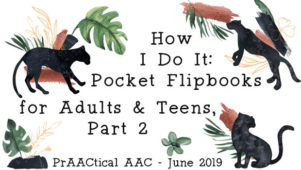
Grilling, wine tasting, horse racing…What did you talk about this weekend? The vocabulary and messaging needs of adults who have significant communication difficulties are often quite different than those of children and youth. Today, we welcome back SLP Katherine Dally who continues to share her experiences in creating and using small flipbooks for adults with complex communication needs. The flipbooks in this post (which can be downloaded via a link later in the article) focus on leisure activities that are perfect for summer. You can see Part 1 and download the template here. ::::::::::::::::::::::::::::::::::::::::::::::::::::::::::::::::::::::::::::::::: How To – Pocket Flip Book For Adults and Teens Have you worked with a client who was given a generic, low-tech paper communication board at the hospital? These are the boards that include pain, yes/no, and bathroom, among other basic needs and wants. With these boards, personalization is limited. The topics can be important, but... [Read More...]
April 8, 2019
by Carole Zangari -
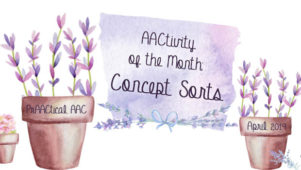
Concept Sorts (learn more here) are often used in vocabulary intervention and academic instruction. Chances are, you’re probably using them already with some of your learners. These easy-to-implement activities can be helpful in teaching AAC as well. There are lots of right ways to do a concept sort. Here is one of them. Select a target word. Print out 2 copies of the AAC symbol for it, and the symbol for No/Not as it appears in the learner’s AAC system. Use these to create a simple 2-column sorting system (e.g., 2 shallow boxes, one with the target word symbol and the other with No/Not + target symbols). Gather a collection of objects or pictures that depict or are related to the target word. Gather a collection of objects or pictures that depict the opposite of the target word or show something completely unrelated. Put the objects or pictures to be... [Read More...]
June 28, 2018
by Carole Zangari -
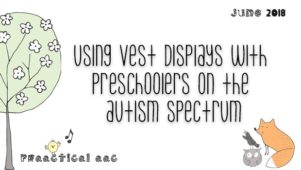
We’re so pleased to welcome back Dr. Carol Goossens’, an AAC pioneer who is an internationally-recognized consultant, SLP, and Special Educator from New York. Throughout her career, she has consulted extensively in a variety of classrooms serving the full spectrum of children with special needs. Dr. Goossens’ has presented both nationally and internationally about her collaborative work with teachers, therapists, and families. In today’s post, she shares a treasure trove of ideas on using wearable AAC. Learn more about her approach to using vest displays in this extensive post. :::::::::::::::::::::::::::::::::::::::::::::::::::::::::::::::::: Using Vest Displays with Preschoolers on the Autism Spectrum When working with students on the spectrum, we often struggle to gain and maintain their attention, especially during group activities such as Circle Time/Morning Meeting. The songs offered during Circle Time, however, create a great forum for working on a variety of communication skills, e.g., claiming a turn, announcing a song, choosing... [Read More...]
May 10, 2018
by Carole Zangari -
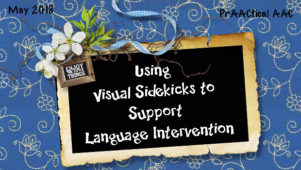
SLPs Lori Sanzeri and Chelsea Collins, creators of Core City, are back to share ideas for implementing AAC in the classroom. Today, they share their experiences in using visual supports as a supplemental strategy for their students who are beginning to use AAC. Enjoy! ::::::::::::::::::::::::::::::::::::::::::::::::::::::::::::::::::: Using Visual Sidekicks to Support Language Intervention Have you ever tried to read a book to your students without providing any visual supports? Do you find yourself having difficulty thinking about what questions to ask? Do you ever feel like the story is too “wordy” or difficult for your students to understand? Have no fear, Visual Sidekicks are here! Visual Sidekicks provide a color-coded communication board of target core and fringe vocabulary along with sentences of 3-5 symbols that simplify the text throughout the story. Children with special needs often demonstrate difficulties during structured literacy activities in the following areas: attending to... [Read More...]
March 8, 2018
by Carole Zangari -
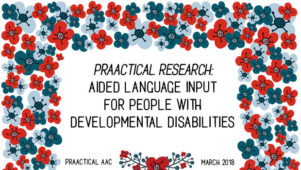
We’re pleased to welcome back Dr. Kathy Howery for another analysis of an AAC research article. Kathy is based in Alberta, Canada, and has worked in the field of AT and special education for over three decades. In the past year, she completed her doctoral studies where she used phenomenological methods to seek to understand the lived experience of speaking with/through a speech generating device. Kathy is currently working as a consultant to schools and school districts across Alberta focusing primarily on children and youth with complex communication needs. ::::::::::::::::::::::::::::::::::::::::::::::::::::::; Allen, A. A., Schlosser, R. W., Brock, K. L., & Shane, H. C. (2017). The effectiveness of aided augmented input techniques for persons with developmental disabilities: A systematic review. Augmentative and Alternative Communication, 33, 149-159. What this Article is All About (The Focus of the Research) This article presents the results of a systematic review of the research into what the authors refer... [Read More...]
August 10, 2017
by Carole Zangari -
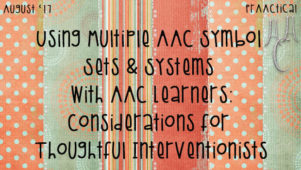
PCS, Pixons, Minspeak symbols, Smarty Symbols, Symbol Stix, CoughDrop Symbols, ARASAAC symbols, Mulberry symbols, Lesson Pix, Sclera symbols, and more. In terms of AAC symbol options, we are living in plentiful times. It isn’t uncommon to see situations like Jonah’s. On a typical school day, Jonah is likely to encounter at least three types of pictures for the same words. He has Smarty Symbols on his AAC app and a classroom core board with PCS, and is using instructional materials using Symbol Stix. These are each great ways of visually representing language, but here’s something to think about: Does it help or hurt Jonah to have 3 different pictures for the same word? There are many options in symbol sets and systems, and each has its own strengths and weaknesses. Here are some things to think about as you and your team are making these decisions. There is no empirical... [Read More...]
May 15, 2017
by Carole Zangari -
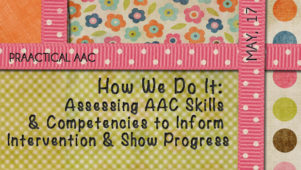
It’s Better Hearing and Speech Month ( #BHSM) and we are highlighting the work of talented AAC SLPs. We’re so happy to have Georgia-based Vicki Clarke back, this time with Holly Schneider, to talk about a longstanding collaboration that more AAC teams need to know about. Vicki’s private practice, Dynamic Therapy Associates, centers on AAC assessment and intervention. She works both with individuals and school districts, and serves children and adults with a variety of challenges and etiologies (e.g., motor disorders, memory, attention and learning difficulties, sensory impairment, neurological differences, syndromes and seizure disorders, congenital and acquired difficulties).Holly is a full time employee of Tobii Dynavox on the Clinical Content and Training Team. She is responsible for developing AAC training materials; and educating teams, professionals and families on AAC applications and implementation. In this post, they tell us about the development of the second edition of the Dynamic AAC Goals Grid.... [Read More...]
September 22, 2016
by Carole Zangari -
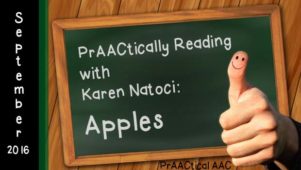
We are so happy to welcome back SLP Karen Natoci who graciously agreed to continue writing about how she uses interactive book reading to build language skills with beginning communicators. You can see her earlier posts in the PrAACtically Reading series here. In this post, she shares activity ideas for two books on apples. You can learn more about Karen and download her materials toward the bottom of the post. Enjoy! ::::::::::::::::::::::::::::::::::::::::::::::::::::::::: Books: Apples by Ken Robbins and Apples for Everyone by Jill Esbaum Adapted and simplified Powerpoint Book Apples by Karen Natoci Core Vocabulary focus: here, in, where Additional Vocabulary focus: Body parts; red, round, yellow, green, COMMUNICATION Matrix (Rowland, 2009) Level: I-VII (all levels!) ————————————————————————————————————————————- It is September and apple time! I chose to feature these books from which to adapt material suitable for students with complex communication needs. I have a simplified power point... [Read More...]
September 7, 2016
by Carole Zangari -
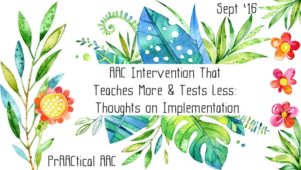
In an earlier post, I shared a graphic on the ways that AAC skills are ‘taught’ versus ‘caught.’ Teaching AAC skills involves the use of specific instructional strategies that give learners information and experiences which result in them being able to communicate more effectively. In many instances, we set out to do just that, but end up with an interaction that ‘catches’ what the student already knows how to do, rather than helping them gain additional skills. There are a few important concepts here. They both have an important role. ‘Catching’ skills isn’t bad. We can do this to figure out what the learner already knows/can do, and give him/her practice with the skill so that it becomes faster and easier to produce. When our interactions ‘catch’ a skill, we’ve created (or taken advantage of) an opportunity for communication. That’s important BUT, it isn’t teaching them anything new. Our learners do... [Read More...]
July 27, 2016
by Carole Zangari -
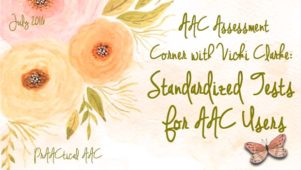
Do you have a love-hate relationships with formal testing? Are you required to use normed tests with your minimally verbal clients? Looking for recommendations on which tests to use? AAC specialist Vicki Clarke has you covered! Like many of you, I’ve had mixed feeling when it comes to using normed assessment instruments with my AAC learners, particularly when we needed to modify the test materials or administration procedures in order for them to be able to participate and respond. If the client can’t point to pictures, give a verbal response, or sit through an entire test, we have no choice but to adapt how the test is administered. As we all know, when we adapt test materials (e.g., putting the test items on an eye gaze board) or procedures (e.g., partner-assisted scanning), we lose the ability to use the normative data. We can, though, compare our learners to themselves at... [Read More...]









